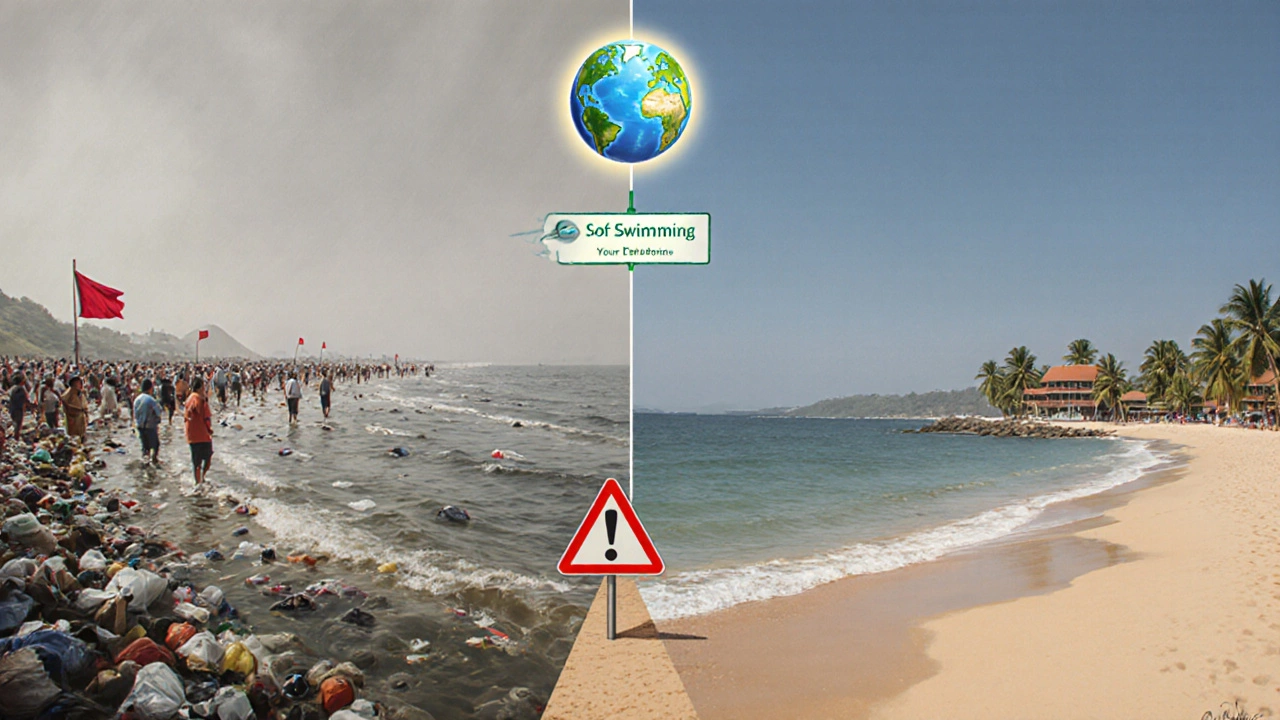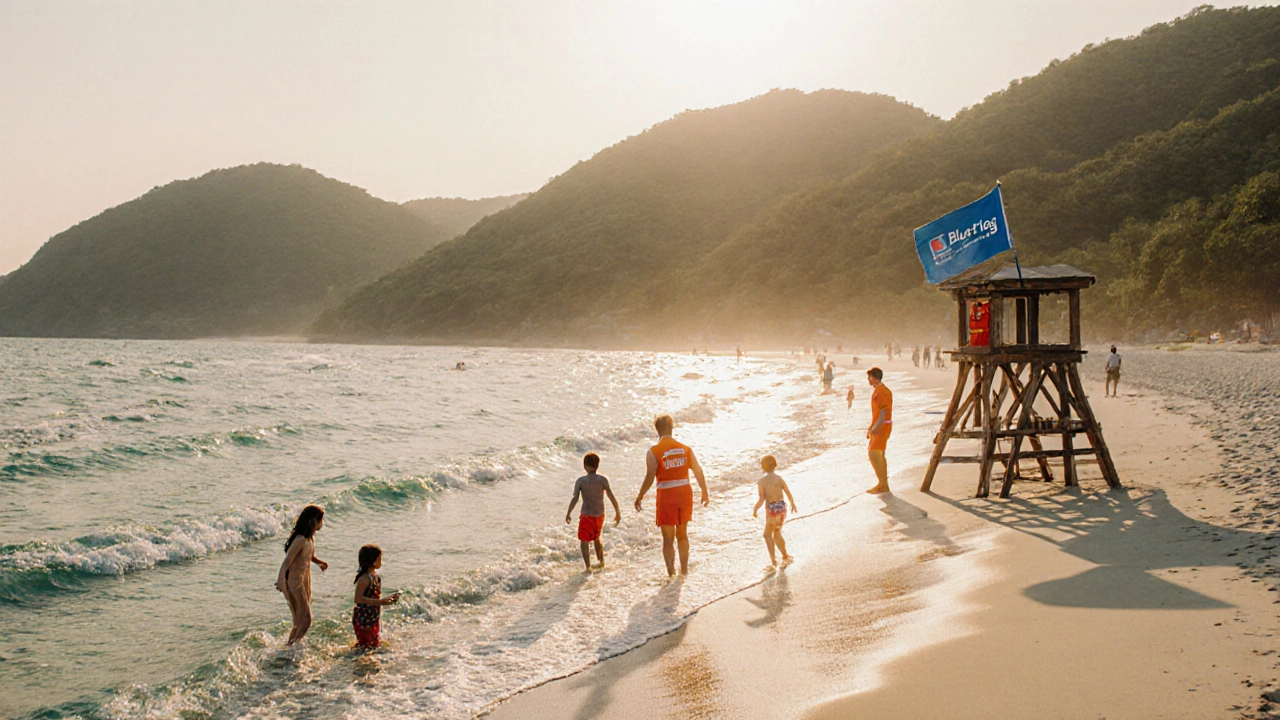India Beach Safety Checker
Check if your chosen Indian beach meets key safety criteria for 2025 based on Blue Flag certification, water quality, lifeguard coverage, and crowd levels. This tool uses data from the article to help you make informed decisions.
India has over 7,500 kilometers of coastline, but not every beach is safe for tourists. If you're planning a trip this year, you need to know which beaches are actually safe - not just for swimming, but for families, solo travelers, and people who want to avoid crowds, pollution, or risky conditions. The truth is, many beaches in India look beautiful in photos, but come with hidden dangers: strong undercurrents, plastic waste, poor lifeguard coverage, or even unsafe water quality.
What Makes a Beach Safe in India?
A safe beach isn’t just about clean sand. It’s about water conditions, local management, emergency services, and how well it’s maintained. In 2025, the Indian government’s Blue Flag certification program has become the gold standard. This international label means a beach meets 33 strict criteria - from water quality and waste management to lifeguard presence and accessibility. Only a handful of Indian beaches have earned it so far.
Other signs of a safe beach: clear warning flags (red means danger, green means safe), visible lifeguard towers, clean restrooms, and local vendors who don’t pressure tourists. Avoid beaches where you see oil slicks, floating plastic, or no one in uniform watching the water.
Top 5 Safe Beaches in India (2025)
After reviewing recent water quality reports, tourism authority data, and traveler safety reviews from 2024-2025, here are the five safest beaches in India for tourists - ranked by reliability, cleanliness, and safety infrastructure.
- Radhanagar Beach, Havelock Island (Andaman & Nicobar) - This is the only Blue Flag beach in the Andamans. The water is calm, crystal clear, and monitored daily. Lifeguards are on duty from 8 a.m. to 6 p.m. There’s no commercial fishing nearby, so no nets or debris. It’s also one of the cleanest beaches in the country - trash collection happens twice daily. Families love it because the shallow entry makes it perfect for kids.
- Palolem Beach, Goa - Unlike the crowded and noisy stretches of North Goa, Palolem is quieter and better managed. The beach has a designated swimming zone with floating ropes to keep swimmers away from strong currents. Local NGOs run regular clean-ups, and the government installed solar-powered trash bins in 2024. The water quality tested as “excellent” by the Central Pollution Control Board in Q1 2025.
- Marari Beach, Kerala - A peaceful, backwater-adjacent beach with no high tides or rip currents. It’s lined with eco-resorts that enforce strict waste rules. No motorized boats are allowed within 500 meters. The water is consistently rated safe for swimming by the Kerala State Pollution Control Board. It’s ideal for travelers who want calm waters and low crowds.
- Chandipur Beach, Odisha - Unique for its disappearing tide, Chandipur is safe during low tide hours (which last 6-8 hours daily). The beach has a dedicated safety team that marks safe swimming zones with colored flags. Water testing shows low bacterial counts, and there’s a 24/7 medical outpost nearby. Avoid swimming during high tide - the current can pull you out fast.
- Ghoghla Beach, Diu - This small, crescent-shaped beach has been fully upgraded since 2023. It’s the only Blue Flag beach in Gujarat. Lifeguards are trained by the Indian Coast Guard, and the water is tested weekly. The beach has a no-plastic policy, and vendors only sell food in biodegradable packaging. It’s a top pick for solo travelers and couples looking for safety without crowds.
Beaches to Avoid for Safety Reasons
Some beaches are stunning - but not safe. In 2024, over 120 water-related incidents were reported across India, mostly at these locations:
- Colva Beach, Goa - High foot traffic, weak lifeguard coverage, and frequent sewage runoff after monsoon rains. Water quality dropped to “poor” in September 2024.
- Marina Beach, Chennai - The longest urban beach in India, but also one of the most polluted. Strong undertows, no swimming zones marked, and frequent reports of trash floating in the surf. Local authorities discourage swimming here entirely.
- Donna Paula, Goa - Popular for sunset views, but the rocky shoreline and sudden drop-offs make it dangerous for swimmers. No lifeguards are stationed here.
- Kovalam Beach, Kerala - While the main stretch is okay, the eastern end has strong currents and unregulated boat operators. Stick to the central area only.

How to Check Beach Safety Before You Go
Don’t rely on Instagram photos. Use these real tools to check safety before you step onto the sand:
- Check the Blue Flag list - Visit the official website of the Foundation for Environmental Education (FEE) to see which Indian beaches are certified. Only certified beaches are guaranteed to meet international safety standards.
- Look at water quality reports - The Central Pollution Control Board (CPCB) publishes monthly data. Search for “CPCB beach water quality [beach name] 2025” - most reports are public.
- Ask locals - Talk to shopkeepers or hotel staff. Ask: “Is it safe to swim here today?” If they hesitate or say “it depends,” walk away.
- Watch the flags - Red means stop. Yellow means caution. Green means safe. If there are no flags, assume it’s unsafe.
- Use the BeachGuard app - Developed by Indian coastal agencies, this free app shows real-time safety alerts, tide times, and pollution levels for 18 major beaches.
What to Pack for a Safe Beach Day in India
Even at safe beaches, preparation matters. Here’s what to bring:
- UV-blocking rash guard (not just sunscreen - it washes off)
- Water shoes (for rocky or coral areas)
- Reusable water bottle and snacks (avoid buying from unlicensed vendors)
- Small first-aid kit with antiseptic wipes and hydrocortisone cream (for jellyfish stings)
- Portable phone charger (in case you need to call for help)
Never swim alone. Even at the safest beaches, accidents happen. Always swim where others are around - and never ignore warning signs.

Why This Matters Beyond Vacation
Choosing a safe beach isn’t just about avoiding a bad day. It’s about supporting responsible tourism. Beaches with good safety and cleanliness standards are the ones investing in local communities, protecting marine life, and keeping the environment healthy. When you pick a Blue Flag beach, you’re voting for better standards across India’s coastlines.
India’s beaches are changing. More are getting cleaned up, more are getting monitored, and more are becoming safe. But you still have to do your homework. Don’t assume beauty means safety. The safest beaches in India are the ones that work hard to stay that way - and they’re worth the extra research.
Are Indian beaches safe for children?
Yes, but only at specific beaches. Radhanagar, Ghoghla, and Marari are the safest for kids because of calm waters, shallow entries, and active lifeguard presence. Avoid beaches like Marina or Colva where currents are unpredictable and cleanup is inconsistent. Always supervise children closely - even at safe beaches.
Can I swim at Indian beaches after the monsoon?
Wait at least 10-14 days after heavy rains. Monsoon runoff carries sewage, chemicals, and debris into the sea. Most beaches become unsafe during and right after the rains. Check CPCB water quality reports before swimming. Even Blue Flag beaches may temporarily suspend swimming after extreme rainfall.
Which beach in India has the cleanest water?
Radhanagar Beach on Havelock Island consistently ranks #1 for water clarity and purity. Its remote location, no industrial runoff, and daily cleaning by local authorities keep it pristine. In 2025, water samples showed zero E. coli and high oxygen levels - the best in the country.
Is it safe to visit beaches in India alone?
Yes, if you pick the right one. Ghoghla Beach in Diu and Marari Beach in Kerala are popular with solo travelers because they’re well-lit, have security patrols, and low crime rates. Avoid isolated beaches, especially at dusk. Always tell someone where you’re going and carry a charged phone.
Do Indian beaches have lifeguards?
Only certified Blue Flag beaches do - and even then, only during daylight hours. Most beaches have no lifeguards at all. If you don’t see a tower, uniformed staff, or warning flags, assume there’s no safety coverage. Never swim without checking first.
Next Steps: How to Plan Your Safe Beach Trip
Here’s your simple checklist before booking:
- Choose a Blue Flag beach - check the FEE website.
- Confirm water quality data from CPCB for the month you’re visiting.
- Book accommodation within walking distance - no need to take risky transport at night.
- Pack smart: rash guard, water shoes, first-aid kit.
- Use the BeachGuard app on the day you go.
If you follow these steps, you’ll have one of the safest, most enjoyable beach experiences India has to offer - without the stress, risk, or disappointment.
